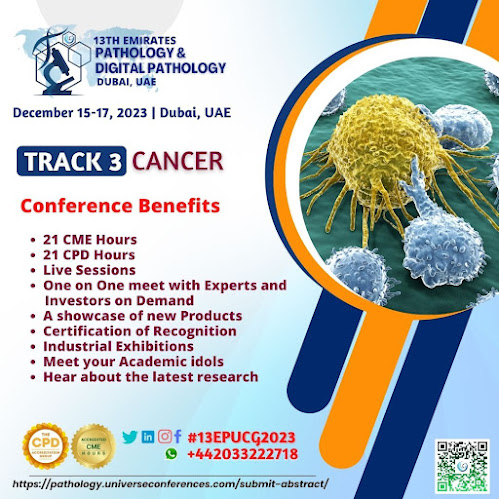Which cancer type is each named? Learn it briefly at the #13EPUCG Conference
How
Is Each Cancer Type Named?
Cancer is called for the bodily region from which it first appeared. Its moniker remains the same as the cancer spreads. For instance, kidney cancer still qualifies as kidney cancer and not lung cancer if it spreads to the lungs. One example of a secondary tumour is lung cancer.
Staging is the process of figuring out whether
and how far cancer has gone. There are several methods for staging cancer.
What
Are the Different Types of Cancer?
Cancer is not just one illness; rather, it is a
collection of illnesses that collectively cause the body's cells to alter and
proliferate out of control. Cancers are categorised either based on the type of
fluid or tissue from which they arise or based on where in the body they first
manifested themselves. Some cancers are also a combination of several kinds.
Carcinoma
A carcinoma is a cancer found in body tissue known
as epithelial tissue that covers or lines surfaces of organs, glands, or body
structures. For example, a cancer of the lining of the stomach is called a
carcinoma. Many carcinomas affect organs or glands that are involved with
secretion, such as breasts that produce milk. Carcinomas account for 80-90% of
all cancer cases.
Types of carcinoma include:
·
Melanoma
·
Basal cell carcinoma
·
Squamous cell skin cancer
·
Merkel cell carcinoma
·
Sarcoma
·
A sarcoma is a malignant tumor
growing from connective tissues, such as cartilage, fat, muscle, tendons, and
bones. The most common sarcoma, a tumor on the bone, usually occurs in young
adults. Examples of sarcoma include osteosarcoma (bone) and chondrosarcoma
(cartilage).
Types of sarcoma include:
·
Soft tissue sarcoma
·
Osteosarcoma
·
Ewing's sarcoma
·
Chrondrosarcoma
·
Lymphoma
·
Lymphoma refers to a cancer that
originates in the nodes or glands of the lymphatic system, whose job it is to
produce white blood cells and clean body fluids, or in organs such as the brain
and breast. Lymphomas are classified into two categories: Hodgkin's lymphoma
and non-Hodgkin's lymphoma.
Types of lymphoma include:
·
Hodgkin's lymphoma
·
Non-Hodgkin's lymphoma
·
Cutaneous lymphoma
Leukemia:
Leukemia, often known as blood cancer, is a bone
marrow malignancy that prevents the marrow from creating healthy red, white,
and platelet blood cells. To fight infection, white blood cells are necessary.
To avoid anaemia, red blood cells are necessary. The presence of platelets
helps to prevent easy bleeding and bruising.
Acute
myelogenous leukaemia, chronic myelogenous leukaemia, acute lymphocytic
leukaemia, and chronic lymphocytic leukaemia are all types of leukaemia.
Myelogenous and lymphocytic are terminology used to describe the sort of cells
involved.
Types
of leukemia include:
·
Acute lymphocytic leukemia
·
Acute myeloid leukemia
·
Agnogenic myeloid leukemia
·
Chronic lymphocytic leukemia
·
Chronic myeloid leukemia
·
Essential thrombocythemia (ET)
·
Hairy cell leukemia
·
Myelodysplastic syndromes (MDS)
Myeloma
The bone marrow's
plasma cells are where myeloma develops. Sometimes myeloma cells gather in a
single bone to create a single tumour known as a plasmacytoma. In other
instances, the myeloma cells assemble in several bones to generate numerous
bone tumours. The term for this is multiple myeloma.
CONFERENCE HIGHLIGHTS
·
Live
Sessions
·
Receive feedback on
a version of your most recent work.
·
Network
with others in your field.
·
Develop
your knowledge.
·
Discover
the newest research.
·
Have
fun and travel to a new location
·
Meet
your academic role models.
·
Participate
in serious discussions and hone your arguments.
·
Develop
your communication and presenting abilities.
·
Acquire
and impart fresh insights and best practises.
·
Gain
knowledge of the newest discoveries and insights.
·
In-person
encounters with industry leaders and decision-makers
·
Network
and maintain relationships with old friends and coworkers.
·
Coffee
and lunch breaks
·
A
two- or three-night stay (on request)
·
Publication
with DOI
·
A
display of new products
·
Recognition
certificates
·
Industrial
showcases
Hello
Dear, Greetings. We are organizing an in-person CME/CPD accredited The 13th
Emirates Pathology & Digital Pathology Utilitarian Conference, Which is
scheduled to hold December 15-17, 2023, in Dubai UAE & Online. And we
invite you to attend as a speaker/listener/poster. Please let me know if you
are interested. If you have any questions,
please Contact us. Email: pathology@universeconferences.com
WhatsApp: https://wa.me/442033222718?text=
Thank
you….
Recent
Blog Posts:
https://emiratespathologyucgconferences.blogspot.com/2023/03/what-is-role-of-pathology-learn-more-to.html
https://medium.com/@traviis.stork/what-is-the-role-of-pathology-6e26937ba64b
https://sites.google.com/view/whatistheroleofpathologylearn/home
https://www.innoget.com/account/my-articles
https://hubpages.com/technology/What-is-the-Role-of-Pathology-Learn-more-to-attend-the-CMECPD-accredited-13EPUCGin-Dubai-UAE
https://www.linkedin.com/pulse/what-role-pathology-learn-more-attend-cmecpd-accredited-stork
https://issuu.com/ucgpathology.cof./docs/what_is_the_role_of_pathology.docx
https://globalhealthtrainingcentre.tghn.org/community/blogs/your_posts/
https://kikoxp.com/posts/22745
https://www.tumblr.com/digitalpathologyucgconferences/711653969924177920/what-is-the-role-of-pathology-learn-more-to?source=share



.png)
Comments
Post a Comment